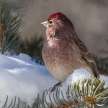
Elegant Crested-Tinamou is a beautiful western Argentinian terrestrial bird and windswept Patagonia. It can be found in flocks of 5-10 birds that scurry through low steppe vegetation, and its downslurred, whistled calls are often heard. The genus, in Argentina known as the martineta, consists of a variety of subspecies which are weakly distinguished. Elegant Crested-Tinamou, though very common in areas of southern Argentina, is only poorly known from Chile. Tinamous are stocky, woodland birds with quite short tails and rounded wings. The two species of crested-tinamous are large tinamous on the rear crown with a long thin crest, and just three toes. Elegant Crested-Tinamou is usually olive grey although it has black and white vermiculations in the plumage. There is also a broad whitish band that begins above the eye and runs down the neck line. With its body shape and short straight crest, the graceful Crested-Tinamou differs from about all tinamous. The only comparable species is the closely related Crested-Tinamou Quebracho, which has more deeply mottled upper parts; longer, more well-defined white stripes on the sides of the head and neck, with the longest such stripe reaching the base of the neck; unbarred inner webs to the primaries; and the appearance of horizontal vermiculations along the breast streaks. Among those two species there is little to no geographical overlap. Adults typically have light greyish brown to blackish upper parts, densely dotted with tiny white or buff spots, larger spots on the wing coverings. Pale brown crown, lightly streaked with black. On the rear crown is a long (up to 75 mm long), narrow crest, the crest feathers black and bent at the tips forward. Auriculars black, with a broad white line bordering above and below. Blackish primaries, barred with white on both websites, small and evenly spaced markings on the outer pages. Secondaries dusky brown, barred or white with a light buff. White Face. Neck sides, foreneck, and whitish breast sides, more or less strongly vermiculated or barred with black and marked with black shaft stripes. White to light ochraceous buff centre of underparts, more or less extensively barred with black on breast, flanks, and undertail coverts, but the belly is generally unmarked. Elegant Crested-Tinamou is omnivorous, but it mostly feeds on nuts, fruits, and leaves for most of the year. A large range of plant species are eaten; the most common are Bromus and Hordeum ears and seeds, as well as Erodium cicutarium, Lycium chilense and Condalia microhylla fruits. Invertebrates are eaten during the year, though most commonly in the summer; insects taken include the grasshoppers Trimeratropis pallidipennis, Dichroplus pratensis, Dichroplus elongatus, Scyllina variablis and Scyllina signatipennis. Crops of these tinamous often often include small stones and sand, but ' only a limited quantity of grit occurs in their crops. ' The song of Elegant Crested-Tinamou is described as ' a low mournful whistle given gradually, wheet wheee wheee, ' and as ' three melancholy whistles, each slightly lower in pitch than the previous one and slightly lower in length, phweeee phuuuu wuuu. ' They also jump up to take the leaves, flowers, and fruit, in addition to gleaning food from the ground. These tinamous do not scrape the ground in search of food. This tinamous forage most often takes place early in the morning and again late in the afternoon, while foraging takes up a greater part of the day in the winter. Elegant Crested-Tinamous also prefers shade and rest or dust bathe at midday while not foraging. Elegant Crested-Tinamous may travel long distances in search of food, but when food is abundant can remain in a small area day by day. These birds tend to walk, as is typical of tinamous, and typically only take flight when startled at close range. Elegant Crested-Tinamous fly quickly, within 3-6 m of the ground, and in a straight line. Glides are interspersed with bursts of quick wingbeats. The distance to flight is about 30- m.
About the Creator
MB
I am a bird aficionado and really enjoy spotting them them on hikes. I greatly appreciate the variety of birds cross North America and the world. They are amazing and intelligent creatures, each so unique and with a wonderful life.






Comments
There are no comments for this story
Be the first to respond and start the conversation.